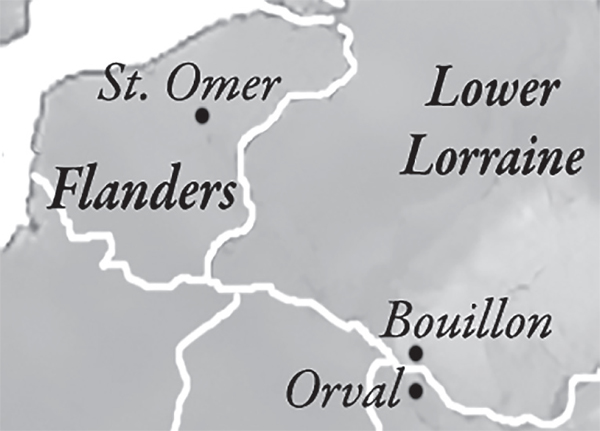32
1121. SAINT-OMER. IN THE HOME OF A CRYPTOGRAPHER NAMED LAMBERT . . .
Godefroi de Saint-Omer arrived back in his namesake town after three laborious years digging under Temple Mount with his fellow knights.
As the Flemish town was previously owned by the late Baudoin I, the scrolls secreted in the Templar co-leader’s tunic would be assured safe passage and protection. The rest was up to a local human encyclopedia named Lambert de Saint-Omer, in whose warm study Godefroi now stood.
Lambert de Saint-Omer, retired canon and schoolteacher of the Chapter of Our Virgin, was not only a wise man (he compiled an encyclopedia on human knowledge) but his personal friendship with Godefroi ensured that the deciphering of the scrolls about to be entrusted to him could be conducted in secret and the results kept in the family, so to speak.1

Whatever Godefroi and the Templars found, these scrolls were just the start. After years secreted on Temple Mount they would abruptly leave Jerusalem and within a historically expedient time frame build an enormous empire, amass an estimated £692 billion ($1.1 trillion) in today’s currency, and found Europe’s first independent nation-state. Clearly they discovered something of great significance on the site of Solomon’s Temple, and the speed at which donations of property were given to the Order meant it was of great benefit to counts, kings, and laypeople alike.

Lambert de Saint-Omer.
Assuming the knights numbered no more than a handful, it is safe to assume the donors had not handed over property by being threatened with violence.
What curious information did these scrolls contain? Vows made by incoming Templar recruits such as Arnold of Sournia, who joined the Order in 1142, unequivocally imply a promise of some considerable spiritual benefit: “I, wishing to come to the joys of Paradise, surrender my body and my soul to the Lord God and the Blessed Mary and the brothers of the knighthood of the Temple of Solomon in Jerusalem.”2
One latter-day member of the Ordre de Sion equally describes the Templars’ treasure as spiritual in nature, consisting in part of a secret that would facilitate a major social change.3